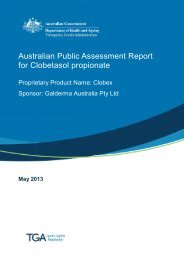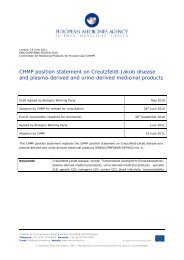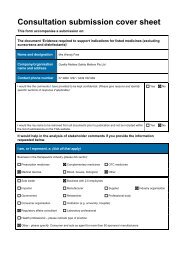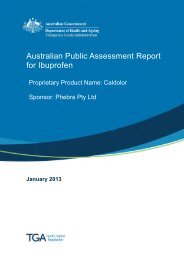AusPAR: Ivabradine - Therapeutic Goods Administration
AusPAR: Ivabradine - Therapeutic Goods Administration
AusPAR: Ivabradine - Therapeutic Goods Administration
You also want an ePaper? Increase the reach of your titles
YUMPU automatically turns print PDFs into web optimized ePapers that Google loves.
<strong>AusPAR</strong> Coralan <strong>Ivabradine</strong> Servier Laboratories (Australia) Pty Ltd PM-2010-03269-3-3<br />
Final 31 October 2012<br />
<strong>Therapeutic</strong> <strong>Goods</strong> <strong>Administration</strong><br />
The ACPM was of the opinion that while the improvement in total exercise duration had<br />
been shown to be statistically significant, there was an absence of meaningful clinical<br />
benefit. During the post-ACPM negotiation period the sponsor and the Delegate agreed on<br />
a slightly more restricted extension of indication specifying atenolol 50 mg once daily as<br />
the beta blocker regimen. This led to the currently approved wording, as indicated above.<br />
Regulatory status<br />
On 15 December 2011, the Committee for Medicinal Products for Human Use (CHMP)<br />
adopted a positive opinion recommending the adoption of a new indication for the<br />
European Union (EU) as follows:<br />
“Treatment of chronic heart failure. <strong>Ivabradine</strong> is indicated in chronic heart failure<br />
NYHA II to IV class with systolic dysfunction, in patients in sinus rhythm and whose<br />
heart rate is ≥ 75 bpm, in combination with standard therapy including beta blocker<br />
therapy or when beta blocker therapy is contraindicated or not tolerated (see section<br />
5.1)”.<br />
A decision was adopted in Switzerland on 28th September 2012 for the following<br />
indication :<br />
Treatment of chronic heart failure: Reduction of cardiovascular events (cardiovascular<br />
mortality or hospitalisation for worsening heart failure) in adults in sinus rhythm with<br />
symptomatic chronic heart failure, left ventricular ejection fraction ≤ 35 % and heart rate ≥<br />
70 bpm, in combination with optimal standard therapy according to the current guideline<br />
recommendations.<br />
Product Information<br />
The approved Product Information (PI) current at the time this <strong>AusPAR</strong> was prepared can<br />
be found as Attachment 1.<br />
II. Quality findings<br />
There was no requirement for a quality evaluation in a submission of this type.<br />
III. Nonclinical findings<br />
There was no requirement for a nonclinical evaluation in a submission of this type.<br />
IV. Clinical findings<br />
Introduction<br />
Clinical rationale<br />
One rationale given by the sponsor for exploring the use of ivabradine in CHF patients is<br />
that ivabradine reduces heart rate by selective inhibition of the sinus node activity and has<br />
been found to have no effect on the intra atrial, atrioventricular or intraventricular<br />
conduction times, myocardial contractility, ventricular repolarisation, blood pressure or<br />
bronchial airways in humans at the therapeutic dose. In addition, the sponsor has stated<br />
that clinical studies showed that heart rate remains elevated in the majority of CHF<br />
Page 6 of 101
















